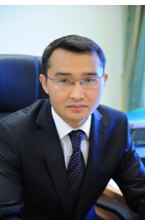 ASTANA – South Kazakhstan is attracting investment, implementing industrialisation and creating new jobs for its citizens thanks to a thoughtful, business-friendly oblast government—and a personal touch—says Deputy Akim (Governor) Saparbek Tuyakbayev.
ASTANA – South Kazakhstan is attracting investment, implementing industrialisation and creating new jobs for its citizens thanks to a thoughtful, business-friendly oblast government—and a personal touch—says Deputy Akim (Governor) Saparbek Tuyakbayev.
South Kazakhstan’s economy has doubled over the past five years, Tuyakbayev said in an exclusive interview, and the share of industry has grown from 15 percent to 24.5 percent. They’ll end this year having launched 100 Industrialisation Map projects, creating more than 10,000 new jobs.
South Kazakhstan is one of the leaders among the oblasts [provinces] in implementing industrialisation projects, which Tuyakbayev attributes to the joint efforts of the akimat [local government] and the region’s entrepreneurs. The akimat can’t directly fund business, but it can spend money on road shows, investment forums and setting up centres to support entrepreneurs, Tuyakbayev said.
The centre, a one-stop-shop for investors and entrepreneurs large and small, has been a key force in creating business, Tuyakbayev, who is 34 and who was educated at the Middle East Technical University in Ankara and at the University of Toronto, said. “The principle was that we tried to look from the point of view of business. No matter whether it’s government, private—what does business need?”
The key needs of business, it seems, are information, an efficient permissions process, access to financing and a bit of personal attention.
“Many investors don’t know where to get government support—subsidies, land, other support,” Tuyakbayev said. “There are lots of programmes, but many people don’t even know their names, let alone their conditions. So we’ve concentrated all that information at this centre. … Consultants at the centre help investors see what kind of government support is suitable for their projects. And when they decide, they don’t have to go somewhere else. … They can be connected with [these programmes] through the centre.”
Then comes the often long process of getting permissions. All permissions documents are available at the centre, Tuyakbayev said, adding that they have halved the administrative time necessary to set up a project. Construction projects, for example, are some of the most time-consuming, taking 160 days on paper but in reality often much longer. “We’ve made it 30 days,” Tuyakbayev said. “Thirty days, plus the time for preparing the project. That depends on the investor—the faster he prepares the project, the faster he gets permission. … This increases the attractiveness of the region.”
The centre also houses representatives from the region’s private banks, as well as government financial institutions, Tuyakbayev said, and investors can compare their options, present their projects and gather information from whichever they choose. “It’s a concentration of all the resources,” Tuyakbayev said, “not just government resources.”
The centre has been open for just over a year and has accepted more than 20,000 entrepreneurs who have been able to have their needs met 95 percent of the time, Tuyakbayev said, adding that nearly US$227 million has come through the centre as financing.
To help smooth processes for bigger investors, the oblast has also set up an industrial zone in Shymkent, where factories can be dropped in and connected to all utilities and communications through one company in a process that Tuyakbayev said saves time and cuts out corruption. They are also financing a training centre in the industrial zone to train exactly the types of workers the new ventures will require. They plan to repeat these zones in all the small cities in the oblast. The first zone has created over 3,000 jobs in two years and unemployment in South Kazakhstan is now at 5.5 percent, Tuyakbayev said. Unemployment for young people has also dropped over the last few years from 6 percent to 3.3 percent.
The programme has also sponsored investment opportunity road shows abroad, including shows in Germany, Italy, Switzerland, Russia, Uzbekistan, South Korea, Malaysia and Turkey. The shows have resulted in 20 large projects totaling US$1.6 billion.
The projects include high-technology production facilities for making electricity transformers with Chinese partners, producing LED lighting, water pumps and solar panel components with German partners, and others.
“You have to work with investors individually,” said Tuyakbayev. “I spend more than 50 percent of my time each day meeting with investors. … We are people; we are not robots. Despite all their calculations, they still have to believe in us. That’s why I have to work personally with them. Besides all the stuff I organise—tariffs, land, money—they should believe in me. That’s why I spend so much time with them. That’s why we have so many projects.”
In a few years, he said, when the projects starting today are open, there will be two or three times more production in the region than there is today. “Before, we had small and medium business. But now, we’ve started to build big factories.”
Much of the revenue from all this development is earmarked for the oblast’s social sphere, Tuyakbayev said. There are already not enough schools in the oblast, and the rapidly growing population—one in four children born in Kazakhstan is born in South Kazakhstan—is outstripping their ability to build more. Despite opening 50-60 new schools and health centres per year, they need more. So infrastructure, roads, schools and health centres are the priorities in the oblast budget. “We are investing 80 billion tenge [US$519 million] in this each year. It’s the biggest budget among the regions in social and engineering infrastructure.”
As for the economic future, the oblast’s priority sectors are the food industry, primarily the intersection of agriculture, food processing and logistic. Other priorities include tourism, pharmaceuticals and, in the more distant future, metallurgy and agro-chemicals. There are currently big projects underway in most of these spheres, including a US$200 million warehouse complex for food products, a new winter sports resort centre 50 kilometres from Shymkent and the refurbishment of the region’s pharmaceutical factory and academy with Polish partner Polpharma.


